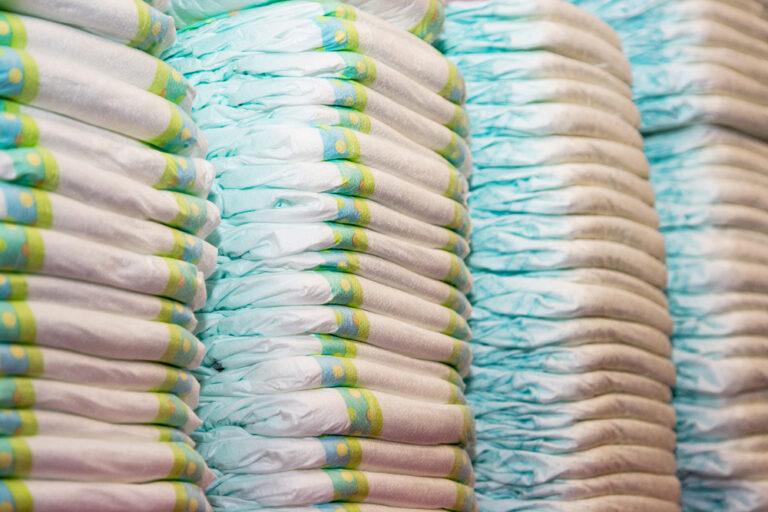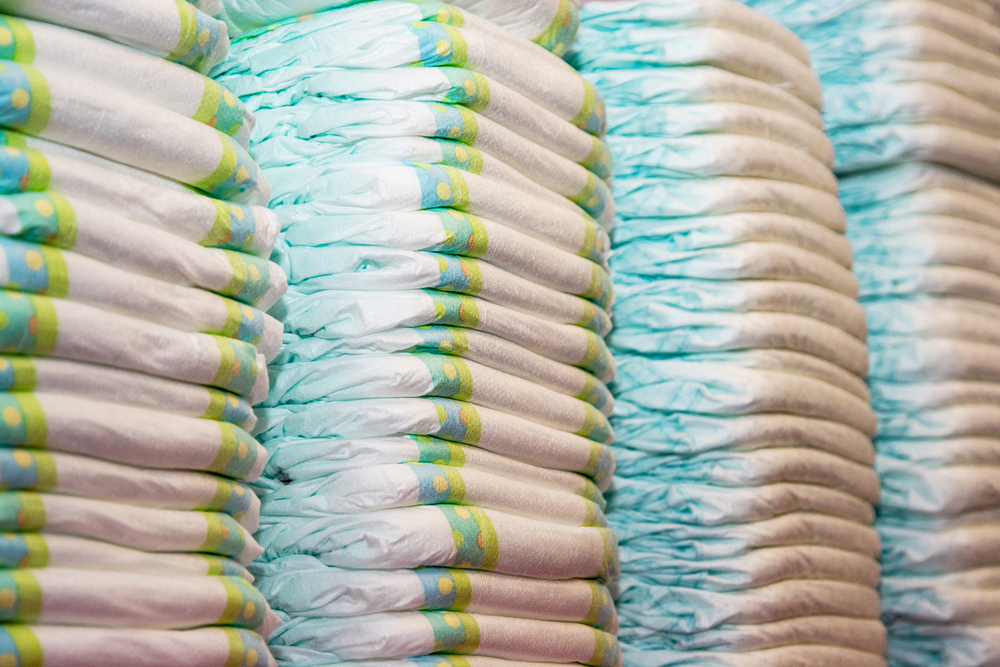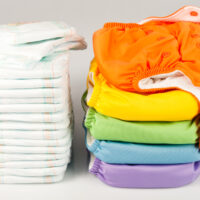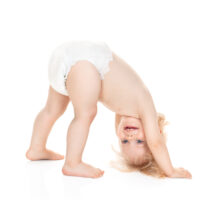Most people use disposable diapers now, although many use cloth diapers as a more eco-friendly option. However, do you know the impact a disposable diaper has on the world?
Most people – especially new parents – have very little time to think about the ramifications diapering has on the planet. No matter what method you use to cover your infant’s tushy, there are consequences for the world.
Get the full scoop here so you can make the best decision for your family.
How Long Does It Take For a Diaper to Decompose?
The short answer is that diapers take about 500 years to decompose. Honestly, though, this is a guess, as plastic wasn’t invented until 1907, and we haven’t had it for even a hundred years, let alone five hundred! But, the scientific community has math and science on their side to make some seriously educated guesses.
An important question we have to ask is- what exactly is decomposition? It’s the process of rotting or decay, basically how long it takes for a product to return back into the earth as dust. With organic matter, the decomposition length is dramatically shorter than new human-made products. Human-made products like plastic bags, CDs, diapers, and even yogurt containers will take ten times longer than, let’s say, a banana peel, to break down and go back into the earth.
What is in a Diaper?
Diapers are made of an inner layer, absorbent core, and a waterproof outer shell. The inner layer or top sheet is the part against your baby’s skin, and most companies do not disclose what goes into the part touching your baby’s delicate skin.
Inside this layer is the absorbent core made to retain liquids. Most diapers use Super Absorbent Polymer (SAP) to trap fluid inside the diaper and also include fluff. The fluff is usually wood pulp or materials made from wheat or corn. While the latter spreads out the liquid, the SAP traps the fluid away from the baby’s skin.
The core makes up the bulk of the diaper and does affect your baby’s skin.
Next, the outer shell keeps liquid trapped inside. It’s made of mostly petroleum-based plastic and is often treated with chemicals, too. A few natural or green companies use plant-based plastic, although most often, the outer shell is not made of recyclable plastic.
A few chemicals are in diapers, too, but most companies do not share what chemicals go into their diapers. Tributyltin prevents bacteria growth. It’s harmful to humans and animals. This chemical doesn’t degrade and remains in the ecosystem and goes back into our food.
Volatile organic compounds (VOCs) are released into the air when exposed to heat, which we can then breathe in. Petroleum keeps diapers from leaking and is the same stuff found in gasoline, kerosene, and diesel oil. Dioxins are often found in diapers and are a known environmental pollutant and highly toxic.
Other undesirables you can find are dyes, fragrance, and phthalates. All of these ingredients can harm your baby’s skin and health. Some babies even have allergic reactions to diapers.
Landfills Full of Diapers
An average year lands over 18 billion disposable diapers in trash cans, awaiting transport to landfills. Not 18 million, but 18 billion dirty diapers in the United States alone!
That’s a whole lot of diapers, but as for the amount of trash we put in landfills, it’s around two percent of the trash filling up space.
Let’s break down those numbers a little. The average baby uses 6 to 8 diapers for the first 2 and half years of their life. That’s just shy of 3,000 diapers a year or 7,300 over the course of their diapered years. Add in another year or even two of pull-ups, and you have another 6,000 disposables going in the bin.
One child using disposable diapers adds over 13,000 disposables to landfills. Times that by the number of babies born each year, which is around 3 to 4 million, and the number becomes astronomical.
If you have never seen the movie Wall-E, watch it now and see what could happen to our world if we fail to reign in the trash problem in our world.
Diapers account for over 7 billion pounds of garbage every year. That’s the equivalent of filling up a baseball stadium 15 times! Now do that every year, and you can visualize how much trash we need to deal with.
While we can burn trash to reduce the amount in landfills, it’s not a perfect science just yet and it’s not available on large enough scales to deal with diapers sufficiently. Add in the wipes and the actual waste in the diapers, and those landfills are ready to burst!
Impact on the Planet
We don’t need to leave such a dramatic mess for our children. Disposable diapers aren’t the only option for containing your child’s bodily functions.
As the third-largest contributor to landfill wastes, diapers aren’t just our problem. Our great-great-great-grandchildren and beyond will still be dealing with the diapers our generation leaves behind.
Another concern about diapers is not just the plastic, but also the chemicals, like polymer, inside the diapers that are dangerous for our environment and even the air we breathe. Diapers are also bleached and linked to carcinogenic chemicals, all of which are bad for our earth.
Overall, diapers add massive tons of trash to our already overloaded landfills and will stay there for not years or decades, but for centuries!
Biodegradable Diapers Facts
You might ask, “what about natural diapers or biodegradable diapers?” A few brands are catching on, although this is not a perfect option just yet.
Scientists are working hard to make diapers that will decompose in landfills. Many have less harmful ingredients and strive for more natural ingredients instead of human-made ingredients.
However, not all eco-friendly diapers will necessarily decompose, nor are they necessarily a better option for the environment. Although these diapers with fewer chemicals and more natural products are better for your baby’s skin.
Eco-Friendly Alternatives to Traditional Diapers
Traditional disposable diapers aren’t the only option. As scientists make new discoveries and see the market for better products for our planet, new options show up. Here are a few of the alternatives to the normal diapering trends in our country.
Natural Diapers
Natural diapers come in all forms from some of the top brands and smaller brands geared toward protecting sensitive skin as well as the environment. With fewer chemicals and creepy ingredients, natural diapers are more likely to biodegrade before 500 years, unlike traditional disposable diapers.
To be a natural diaper, the product needs to be made of plant-based material instead of petroleum-based ingredients (plastic). Plants decompose, plastic does not. Keep in mind though, traditional landfills aren’t designed to allow anything to decompose as they don’t provide oxygen, soil, or microorganisms.
Even if natural diapers can’t decompose due to system layouts, they are better for your infant’s skin and for the environment. Over time, they will breakdown, whereas disposables won’t.
Bamboo diapers are one of the best new options available. They are soft, comfortable, absorbent, and cost-effective. Moreover, they are chemical-free and made of plant-based products! Bamboo also helps to inhibit the growth of bacteria, and it’s biodegradable.
Definitely check out disposable bamboo diapers but also check out options that are plant-based and free of plastic.
Cloth Diapers
While cloth diapers are definitely gentler on infant skin, they aren’t necessarily better for the environment. They require more electricity and water than other diapers because you need to wash them over and over again. Of course, the same can be said for clothing, and we wash that all the time and yet no other options exist for dressing ourselves.
Some studies suggest that cloth and disposable diapers tie in regards to their impact on the environment, but for different reasons. While disposables have a larger carbon footprint, the water usage of other diapers can weight out the benefits, and so on. No option is perfect.
What’s more, while cloth diapers are great for baby’s skin, they aren’t for yours if you have to wash them by hand. You have to get the contents out before you toss them in the washing machine, which takes up even more water!
The true advantage of cloth diapers is you can use them again and again and end up putting less waste into the world. Even if you buy twenty cloth diapers and throw them away and they don’t decompose, it’s a much smaller number overall. In two days, you could throw away 20 disposable diapers, while in two years, you would at most throw away 20 cloth diapers.
If you have multiple children and reuse those diapers, you save the environment even more diaper waste. Also, they are made of higher quality and skin-friendly materials.
Cloth diapers aren’t as convenient and require a lot more work than disposable diapers. Those who want to reduce their carbon footprint and protect sensitive skin stand to benefit the most as the benefits outweigh the extra work.
Hybrid Diapers
Hybrid diapers mix the disposable world with the cloth diaper world. What’s involved, and how does that work?
It’s simple: you get a cloth diaper and put a disposable liner inside of it.
Using liners with a cloth diaper is just like what us moms do when we have our period, just with a baby. Reusable undies with a throwaway pad. It cuts down significantly on the amount of waste and doesn’t use plastic, making it better for the environment.
What’s even better about hybrid diapers is they are easier to travel with, as you can bring a few diaper shells and the thin, more compact, disposable liners. Even better, the disposable inserts are often biodegradable, and you can flush them down the toilet in a pinch!
However, the inserts do cost a significant chunk of money and increase your cost. One of the main benefits of cloth diapers is the savings over disposable diapers and inserts will up the cost, but are still cheaper than diapers and better for landfills, too. You can even buy cloth inserts to save more money.
Elimination Communication
Despite the fancy and long name, Elimination Communication simply means going diaper-free with an infant. Sounds crazy to our culture obsessed with convenience, but many cultures don’t use diapers at all and wouldn’t if they could!
Honestly, this method is the best for the environment, but western culture doesn’t often make space for learning to read your baby’s cues and getting them to a potty. However, this option often gets babies potty trained in months, not years, cutting down on costs.
Communities that train their kids to avoid diapers and learn their babies’ pottying cues will then do the same for their babies later on. It’s even considered a wonderful bonding experience, too.
However, the upfront work is intensive, and most parents cannot get enough maternity leave in America to make this method possible.
Stay at home moms or families who can find a nanny or baby sitter willing to work with a baby can achieve success. In the process, they can help prevent global and landfill issues.
Diapering actually goes against potty training as you spend the first two years teaching your baby to fill a diaper and sit in it until you change them. Then when you think they are old enough, you train them to suddenly start noticing what you trained them out of noticing!
Babies hate to be dirty and cry when they are wet as infants, but in a few months in diapers, they learn to ignore the feeling of wetness. Also, diapers soak up the liquid and keep them dry and desensitize baby to the feeling they were born with!
You can train from birth when it comes naturally or train later when you have to reverse train your toddler.
Costs of Diapering
Stores like Costco and Walmart do a great job of making diapers look affordable. However, if you use disposable diapers and wipes, you could spend, on average, $3,000 over the span of infancy. Add in the pull-up years, and it drives the cost up to $6,000. We haven’t even added in baby wipes yet or diaper rash creams.
Diapering costs a lot of money. Even if you go with cloth diapers, you are looking at a substantial upfront investment. A good cloth diaper costs between $10 and $20 each. You will want to have at least two days worth to cut down on how often you need to wash diapers. Twenty diapers would cost $400.
You may even have to buy different sizes as your baby grows. Don’t forget cloth wipes either.
Wipes are another cost as you will need a minimum of one pack of wipes a week with three packs or more, especially if your baby has had an explosive week! Wipes alone can run you about $300 a year or more.
Moreover, if your baby has sensitive skin or you want better quality or more natural diapers, you will pay a premium. The nicer the diapers, the more they will cost. It’s the difference between Walmart’s clothing and Mall clothing. Even with coupons, diapers, and wipes will take up a significant portion of your monthly budget.
Now think about the fact that you are investing all that money into keeping your baby dry containing their mess, and it’s hurting the environment and your wallet.
Convenience costs a lot of money for both you and the world.
FAQs About How Diapers Decompose
Can I put biodegradable diapers in compost trash?
No. Most diapers that are biodegradable or even eco-friendly aren’t compostable. Why? Because they often have some synthetic components. A few options truly compostable diapers are available, and more will come with newer and better technology.
If you want compostable diapers, consider using hybrid liners. Also, contact companies with biodegradable diaper brands and find out from the source if their diapers are ready to go in the compost bin. Even the options that break down faster than traditional disposable diapers may not break down in a small-time backyard compost bin.
Instead, you may be able to ship compostable diapers to commercial or industrial compost companies that are better equipped to handle minor synthetic materials.
Are there any truly eco-friendly ways to diaper a baby?
The only truly eco-friendly way to diaper a baby is to not diaper a baby. We mentioned elimination communication above because it’s a method used throughout the world and even in the past for generations. However, it’s not always feasible for your family.
Your best bet is to do what works best for your family. Hopefully, what works for your company will provide some relief for our engorged landfills, too! You need to find what works for your beliefs, budget, and baby’s skin, too.
What should I look for in a Diaper?
The best bet for a diaper is to find one that won’t harm the environment or your baby’s skin. Look for a diaper that is chlorine-free, fragrance-free, phthalate-free, dye-free, and, if possible biodegradable. Some of the better options include Seventh Generation, Babyganics, or Nature Babycare.
Look for words like free and clear or hypoallergenic. Earth-friendly is another option as is eco-friendly. Diaper companies are slowly catching on that mom’s want diapers that don’t harm babies, and babies want comfortable diapers that don’t cause painful rashes.
Final Thoughts
Disposable diapers take a long time to decompose and put a lot of trash in landfills where they will stay for centuries! Many companies are starting to look for alternatives to help reduce the burden on our environment. No one option offers the perfect diapering situation for parents, babies, or the planet.
With time, we will have new innovative ideas with better opportunities for the environment. For now, focus on the option that works best for you and your family. If you have the option to lighten the environmental load, then definitely consider alternative diapering methods.







